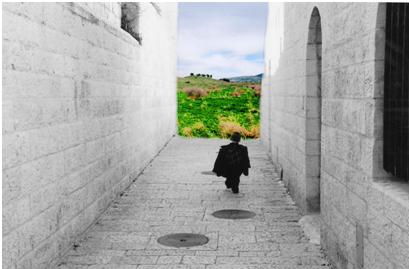The first time I entered the gan, I was greeted by a troop of three year olds chirping, "What's your name? in a language I barely knew. “Jessica,” I answered, and they repeated the unfamiliar “Dshess-ee-ca” hesitantly before encircling their tiny hands around my fingers and leading me to the toy trucks.
Just as my name is new to them, so too do I have trouble with their names, and just as sometimes I have trouble understanding the words they garble between lips new to speech, so too do they give me puzzled looks when I correct myself nervously while I speak. Still, somehow, we have a good time.
I had taught in a preschool before, and there I had used words freely and playfully to engage my students. “What is that?” I would ask them, and if they asked me the same question, I’d give a preposterous answer that would make the children shriek with gleeful laughter. At Gan Pshushim, where I volunteer for six hours every week, I am often silent.
Different types of students are drawn to me now than before, in America. When I was at an English-speaking preschool, the most outgoing students were eager to tell me a story or make-believe with me. Now, it is the quietest and smallest students who look at me through wide and trusting eyes. Like me, they don’t want to speak, they are afraid of making mistakes. I stumble over simple words as I ask them if they would like to play with me, to dance with me, to bake imaginary cakes with me in the sandbox. They nod, silently, and follow me wherever I go.
Ours is a wordless language, and as a writer, a literature enthusiast, and an avid Scrabble player, it was a language I had never used so fully until now. We put puzzles together without knowing the names of the objects we’re creating. We dance to songs with unfamiliar words. We ask for food by pointing, we read books by looking at the pictures.
The other teachers don’t speak our language. Whether they are asking in soft, soothing voices or chastising with harsh consonants and sharp tones, whenever they ask these children to speak, I can feel and understand their fear. They shake their heads, cross their arms, and shrink into themselves.
But when I don’t ask them to speak – how we have fun! Once I sat for a full half hour in the sand box, piling sand and sifting it between my fingers, two children on my lap and three by my side, in complete silence.
Sometimes we talk. I say something in Hebrew, probably incorrectly, and they process it slowly, and sometimes they answer me softly. If I had been busy with the more extroverted children, I may not even have heard their response.
And what have I learned? Is it a lesson about patience? About the ability to connect to people regardless of the divide? About perhaps the needlessness of language?
It’s even more simple than that, I think. It’s about seeing the students who are to shy to want to be seen, and about knowing that they have something to say, if only you ask the right questions, in the right way. Reaching out a hand might be just the question that they need, and even if I had all the words in the world, maybe it would still be the best question to ask.
--------------------
Incidentally, I do actually spend most of my time here not in preschool, though that might not come out in these blog posts. Today, for instance, I woke up early, went to class where I learned about the Holocaust - about more specifically the decision making process that led to the Final Solution and whether it is more a result of Hitler himself or the entire administrative and institutional apparatus. After that, I went to Hebrew class, where we read a bit of reportage by Amoz Oz. I stayed after to talk to my Hebrew teacher about the paper I had just turned in - the first paper I've ever written in Hebrew - which she offered to correct, grade, and then hand back before the deadline so that I can revise it and turn it in a second time if I would like. Over lunch I studied Yiddish, and in the afternoon I read a story by Abraham Reizen with my Yiddish class. The story, called "Feminine Fears" is about a woman who is losing her eyesight and is afraid her husband will divorce her as a result. I then went to my class on Mendele Mocher Seforim, where we compared "Fishke the Lame" and "The Travels of Benjamin the Third" - though as it turns out I'd read the wrong version of Fishke the Lame, so it was hard for me to follow the conversation. I came home very tired, cooked myself dinner and watched a little Israeli TV (OK, so it was American TV with Hebrew subtitles...) and then started writing this essay. All of this is by way of a clarification that I do, in fact, have a substantial life outside of the gan. (gan = preschool)

3 comments:
Jessica,
Would you be willing to write a post (or post one of these) about your experience on the CBI Preschool blog? I've loved reading your comparisons.
Ellen
sure! I'd love to. I'll send you something by the weekend.
I am moved by the ways you are able to communicate with the pre-schoolers in your life. The "language of silence" is a beautiful experience of acceptance and sharing, and I am sure those little ones who sit beside you are learning so much through your smiles, your affection and playful creativity.
Also glad to see how much you are learning from, and adding to, life in Israel with other adults as well!
Post a Comment